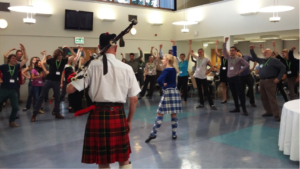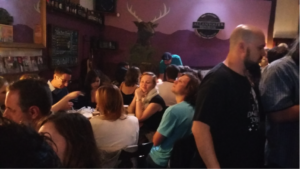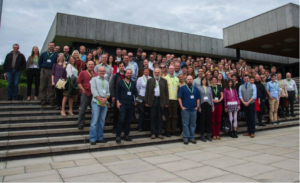Letter from the Editorial Board
Human Ethology Bulletin, Volume 32, No 1, 1-5, published March 31, 2017
DOI: https://doi.org/10.22330/heb/321/001-005
The University of Stirling, nestled between the Scottish cities of Glasgow and Edinburgh, was the stage for the 23rd Biennial Congress on Human Ethology, in August 2016. In true ISHE spirit, the organising committee were keen to create as many opportunities as possible for delegates to immerse themselves in Scottish culture and tradition, and organised a packed calendar of social events. This began with an opening ceremony with a piper, and live performances of traditional Scottish dancing by the Stirling Highland Dancers (with socially mandated audience participation, see figure 1!), This was followed by dinner and whiskey tasting overlooking the beautiful University campus, cloaked in the shadow of the Ochil Hills.
Figure 1: Native Scots demonstrating local Highland Dancing and piping rituals to naïve travellers. After some persuasion the delegates bravely attempted the ancient, intimidating, and much revered Highland Fling.
On Tuesday evening delegates were tasked with foraging for their own meals in the small spa town of Bridge of Allan, just north of Stirling. The majority of delegates overcame this challenge with ease, making their way to the Allanwater Brewhouse to sample the selection local ale (This gruelling research practice is detailed in figure 2).
Delegates visited Stirling Castle on Wednesday afternoon, which sits atop a volcanic rock known as the Stirling Sill, dominating the Stirling skyline. The castle is said to be one of the most important Castles in Scotland, and is often called the ‘key to the kingdom’ due to its strategic placement on the boundary between the highlands and lowlands, and for its utility as the furthest downstream crossing of the river Forth (at least until the 1890’s). This key location has made Stirling an important military fortification for hundreds of years with the castle itself at the centre of at least 8 sieges and seen the coronation of numerous Scottish Monarchs, including Mary, Queen of Scots in 1542. Undaunted by the day’s events, delegates later took part in a small scale Highland Games, with many trying their hand at traditional Scottish competitions such as caber tossing, archery, and haggis rolling!
Figure 2: Social foraging recorded in the small village of Bridge of Allan, Stirlingshire, Scotland.
On Friday evening the conference banquet was held at the Stirling Court Hotel on the University of Stirling campus, and presented another opportunity for delegates to practise their Scottish Dancing skills during the Cèilidh. This traditional social gathering involves lively, Gaelic music played with enthusiasm while guests of varying skill levels try to navigate their way through a selection of Scottish group dances in a test of physical endurance, and numerical literacy (being able to count to four, eight and sixteen is key!).
A final social day allowed delegates a further opportunity to explore more of Scotland’s hidden treasures. There was a trip to Doune Castle – a 14th Century castle with a 100ft high gatehouse, (now better known as ‘Winterfell’, in the TV series Game of Thrones, and which features both in the recent Outlander series, and the classic Monty Python and the Holy Grail). Those who had had their fill of castle-based adventures visited the Deanston whiskey distillery on the banks of the river Teith (Figure 3). Delegates then made their way to the Trossachs National Park, where some conquered Ben A’an, a ‘mini mountain’ standing at 461 metres tall (see figure 4.), before relaxing on a leisurely boat tour of Loch Katrine.
Figure 3: Delegates enjoying a tour of Deanston Distillery.
Figure 4: The view which greeted those who conquered Ben A’an.
But what of the Science?
As usual the conference programme was large and diverse, with 45 poster presentations and over 70 talks presented in two symposia and a further fourteen sessions covering a range of topics from cooperation to faces, social learning, attractiveness, mate choice, competition, vocal perception, romantic relationships, environment and behaviour, social cognition and the roots of human nature. Five plenary sessions were held over the course of the congress. The conference began in earnest with the first plenary talk given by Nancy Segal who gave an overview of twin research and the value it brings for ethology and for an evolutionary perspective. This was followed by a plenary on the range of cues which are detectable in human faces and their attractiveness which was given by David Perrett. Malinda Carpenter presented a broad range of work investigating the development of social affiliation and groupmindedness in human infants, and Benoist Schaal presented his body of work investigating the coevolution of olfactory communication between mothers and their offspring across a range of mammalian species (including humans), with a focus on infant feeding. Finally, Robin Dunbar concluded the plenary sessions for the week with a discussion of the utility of big data in the investigation of human social networks and behaviour.
The International Society for Human Ethology is renowned for the support it shows to students and early career researchers, providing free accommodation for student conference/summer school delegates who are presenting work as first authors, and by recognising quality research with a number of prestigious awards. At this years’ congress three individuals were given Linda Mealey awards recognising research conducted with scientific integrity and an ethological relevance. The prizes awarded were to a range of research topics; Jordan Raine presented his findings showing an association between acoustic characteristics and physical strength in humans, and Jakub Binter discussed his findings investigating the effects of mate competition for females on male hormone levels, non-verbal behaviour and vocal modulation. Finally, Eva Reindl recieved a Linda Mealey award for her research which provides evidence that human children are capable of spontaneously using tools to solve a task without the need for social demonstration.
ISHE also annually confers poster awards to student first presenting authors who have created clear and original posters which present research with a focus on either observed behaviour or which is set within an ethological/evolutionary theoretical context. This year three prizes were awarded to students presenting outstanding research. Juan Du, from University College London, was awarded a prize for her presentation of findings investigating the effects of grandparents on successful childrearing in a pastoralist society, Hannah Turrell from the University of Stirling, presented findings concerning factors which may underpin the utility of Equine Therapy for humans and Moritz Köster (previous recipient of an Owen Aldis award) won an award for his research comparing the cross cultural development of perceptual processes and observational learning in 5 year old children.
This current special edition of the Human Ethology Bulletin offers a small window into the conference with a selection of peer-reviewed publications which were originally presented in Stirling. Kruger and colleagues (2017) report a study set in an environment with a uniquely split allegiance between two American Football teams, allowing them to directly observe coalitional behaviours related to this rivalry. Sharp and Hamilton (2017) also present a study of an observational nature; they recorded women after playing a game of Jenga, finding that gaze duration differed for winners and losers. This is a particularly valuable finding as men are more often the focus of research investigating competition. In keeping with this focus on female competition, Fisher (2017) provides a theoretical review, and a call to arms for researchers to investigate the role of both competition and cooperation between mothers. There is also some interesting research presented by Eryaman and Roberts (2017) investigating the presence of mutual olfactory recognition between mothers and offspring, and a manuscript by Pollet and Little (2017) offering guidelines for the use of forced choice methodologies in Ethology and Evolutionary Psychology.
I thoroughly enjoyed being part of the organising committee as well as attending the 2016 congress, and I was delighted to be asked to help edit this special edition of the Human Ethology Bulletin. We received a lot of interest in the form of manuscript submissions and I hope that our readers agree that those published here reflect the diversity of methods and hypotheses that were presented in the Congress at Stirling. I would like to say a final thanks to the conference organiser, Craig Roberts, and the programme committee for the work they put in to organise such a fantastic congress, to Elisabeth Oberzaucher for her dedication to the Human Ethology Bulletin and her work as Editor-in-Chief, and to all of the authors and reviewers for their work on this special edition.
Figure 5 Farewell from Stirling, Scotland.
ACKNOWLEDGEMENTS
I would like to thank Vít Třebický for the wonderful photos which he took during the congress.
REFERENCES
Fisher, M.L., Burch B. & R.I. Sokol-Chang (2017). A Theoretical Proposal for Examining the Integration of Cooperative and Competitive Mothering Behavior. Human Ethology Bulletin, 32(1), 6-16. DOI
Kruger, D.J., Day, M., Duan, A., Heyblom, A., Juhasz, D., Misevich, S., Phaneuf,C., Saunders, C., Sonnega, P. & Sreenivasa, V. (2017). Understanding Variation in Reactions to Displays of Allegiance. Human Ethology Bulletin, 32(1), 17-28. DOI
Pollet, T. & Little, A.. (2017). Baseline Probabilities for Two-Alternative Forced Choice Tasks When Judging Stimuli in Evolutionary Psychology: A Methodological Note. Human Ethology Bulletin, 32(1), 53-59. DOI
Roberts, S.C. & Eryaman, F. (2017). Mutual Olfactory Recognition Between Mother and Child. Human Ethology Bulletin, 32(1), 42-52. DOI
Sharp, M. & Hamilton, G. (2017). Female Gaze Behavior, Status and Menstrual Cycle: An Exploratory Study. Human Ethology Bulletin, 32(1), 29-41. DOI
ISSN: 2224-4476






